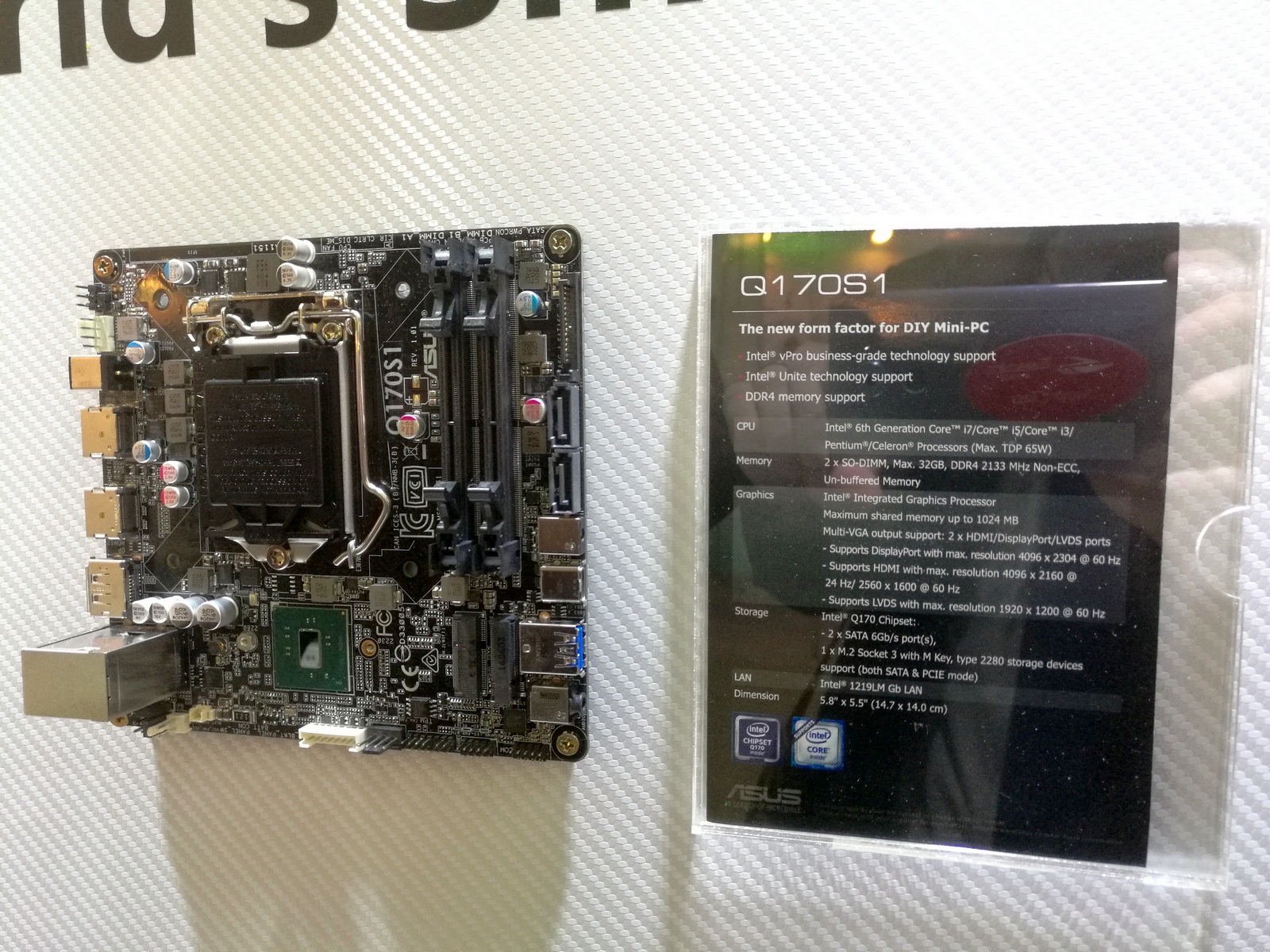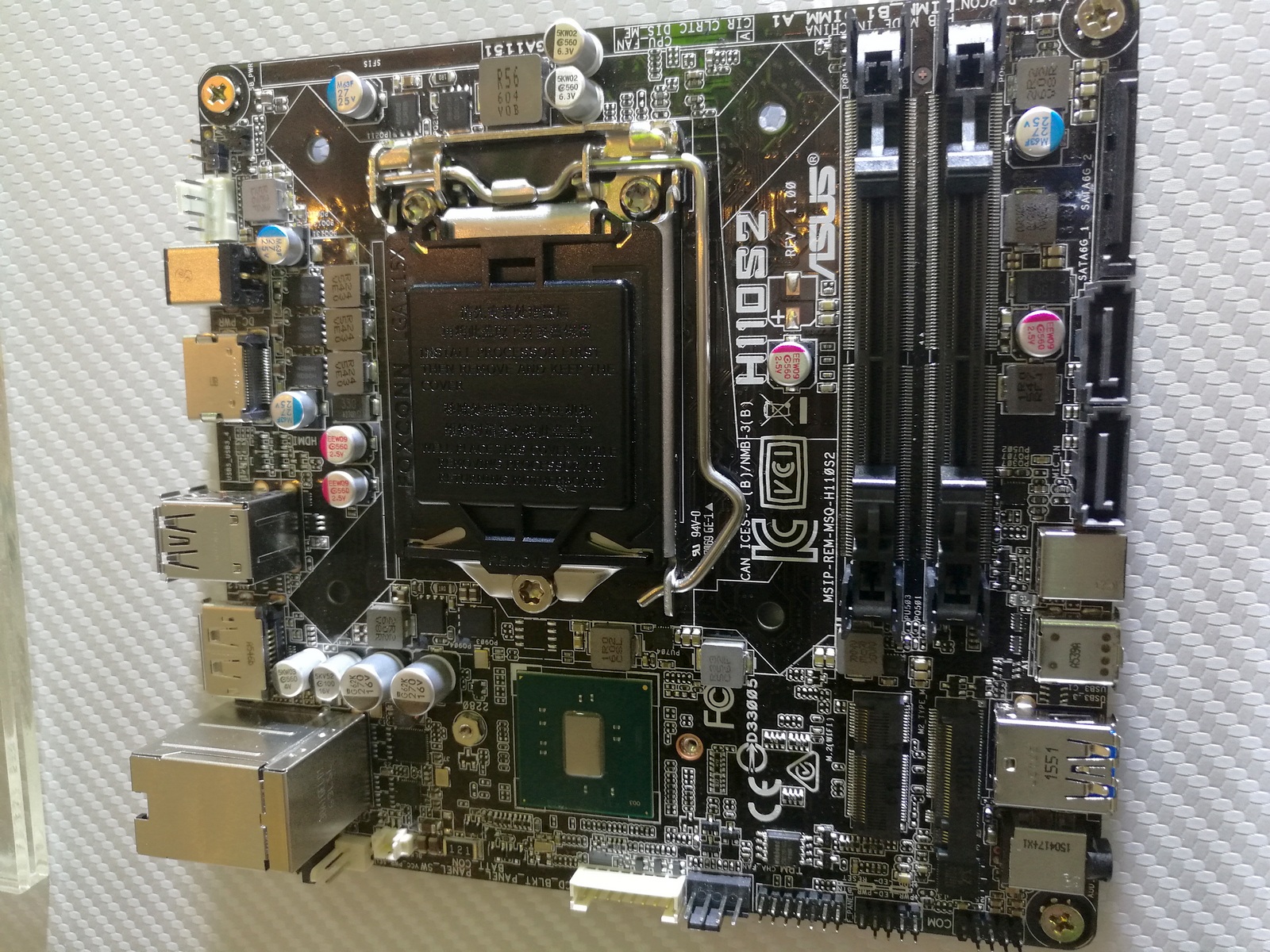ASUS at Computex 2016: The 10 Years of the Republic Of Gamers (ROG) Booth Tour
by Ian Cutress on June 22, 2016 8:00 AM ESTThe three major form factors for custom build personal computers, in order of popularity, are ATX, followed by micro-ATX and then mini-ITX. That also happens to be the order of size as well, from largest to smallest. Earlier in this piece we spoke about how motherboard design has not really changed from these three as of late, mostly due to compatibility and how everything in the industry currently works. However, at IDF in 2015, Intel announced a new form factor for mini-PCs relying purely on integrated graphics: the Mini-STX platform (also known as 5x5, for 5-inch square).
5x5
Before I left for Computex, I asked our editors want they knew would be at the show and what they would like me to cover. One of the responses from Ganesh was ‘anything Mini-STX’. We saw a couple of things at CES, although mostly pre-built mSTX systems. Luckily for Ganesh, ASUS had three motherboards on display.
The first up is the Q170S1, using the Q-series chipset for business level customers and vPro support. We haven’t typically covered the Q-series at AnandTech, however the Q170 attempts to mirror a lot of what the Z170 does but under the provision of a professional grade, managed system that doesn’t go into Xeon. This includes business level support, a separate firmware with control options, and a number of other things. There is an extra cost to the Q-series over the H-series chipsets, around $12 list price, but for the business side benefits this is usually a small price for manageability. In this case, the Q170S1 can use any Skylake processor up to 65W (up to i7-6700), two DDR4 SO-SIMM modules, and supports M.2, SATA, M.2 for WiFi, and rear panel 19V power. All graphics capabilities come from the CPU, and there’s also a vPro enabled network port to facilitate network control.
On the cheaper side of the coin are the H-series variants. These are strikingly similar in board layout, with the S2 version having dual network ports (one Intel I219-V and one Realtek 8111H) whereas the S1 version only has a single Intel I219-V. Specifications match up to the Q170S1 motherboard otherwise, with 65W processor support, but nothing vPro related.
Mini-STX is a drive for Intel towards the more industrial side of the market that wants upgradability. There are a number of platforms already in that space, such as the Intel NUC, Core-M, Atom, ECS LIVA, the MSI Cubi and others, however they are all using soldered down processors. Mini-STX enables a bit more customization within Intel’s platform structure, as well as more performance.













43 Comments
View All Comments
alphasquadron - Wednesday, June 22, 2016 - link
I used to think that too. I would think that the market for young kids who can afford such huge expensive machines would be quite small as it would it would compose of rich people and not middle class which is much larger market. But as companies make more crazy led shiny cases and even have ram modules that have lights and crap on them, I want to say that either they are just dumb and don't know how to sell stuff or that they have much more real live market data then I do and that these things actually are a good thing to make. I could never see it but maybe these things do provide a good revenue source for the company.Gastec - Wednesday, August 31, 2016 - link
I'm not sure that's the fact in North America. Not since the 15-30 years of age group queued for miles and waited for days to buy $500-600 iPhones.hechacker1 - Wednesday, June 22, 2016 - link
I went with another ATX case because I wanted a silent build, which includes AIO radiators for when you are actually using a Broadwell-E at 100%, along with powerful GPU. They can dump out a lot of heat.Right now my 6800k is using 45w at idle with a 4.3GHz overclock. That's according to the motherboard sensor on the Strix x99 Gaming that was mentioned in this article.
So while 45w isn't that much and can easily be handled by a HSF, at full tilt it's rated for 140w TDP (probably less because the 6800k is cut down).
Anyways, that's to say since I do VR with it, SLI really isn't a factor today and I use a single GPU. What ATX does allow is future further expansion via add in cards, and great and silent cooling. My whole rig has fans that are less than <1000 rpm at all times, and so it's almost always silent.
Bragabondio - Wednesday, June 22, 2016 - link
Nice rig heckhacker! Nowadays the components are getting more power efficient so I am planning on downgrading from 650W power supply to 550W one. As for silent build I am pretty sure I could make my rig as silent as I need it in mATX case (I am ready to go with minimum overclock to keep the noise down). In the eternal dilemma between firepower and mobility I prefer mobility (within a reason).BrokenCrayons - Thursday, June 23, 2016 - link
I'm continuing to use an ATX case for cooling, but the motherboard inside it is mATX since I finished my most recent upgrade. I briefly considered grabbing a smaller case, but it seemed like a waste of $30 to pick one up when there's nothing wrong with the old Lian Li tower on wheels from 2008 aside from the fact that it's got more space than I need right now.milkod2001 - Thursday, June 23, 2016 - link
Because it might be much easier to design full atx LGA 2011-v3 motherboard with all features enabled than micro/mini atx variant. I don't see that as a big issue though. You don't have to get monster case for that. Just get the smallest decent case for full atx mobo and have it sitting under table. Or don't go for LGA 2011-v3 get something simpler if you don't need all features if offers.fanofanand - Wednesday, June 22, 2016 - link
Nice work Ian, thanks for the info!madwolfa - Wednesday, June 22, 2016 - link
What's up with leather jackets?BrokenCrayons - Wednesday, June 22, 2016 - link
It's probably just attire the company's employees believe will appeal to people within their target market.iamkyle - Wednesday, June 22, 2016 - link
Of course, the x99 Edition 10 board doesn't come with 10GbE. But still commands the price premium.Looks like ASUS is all about money instead of delivering actual value.